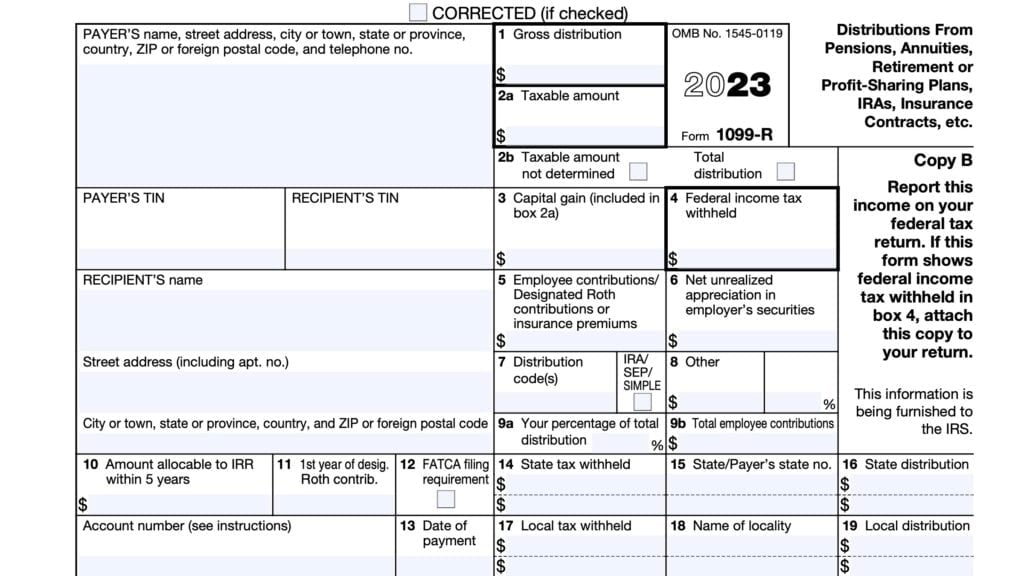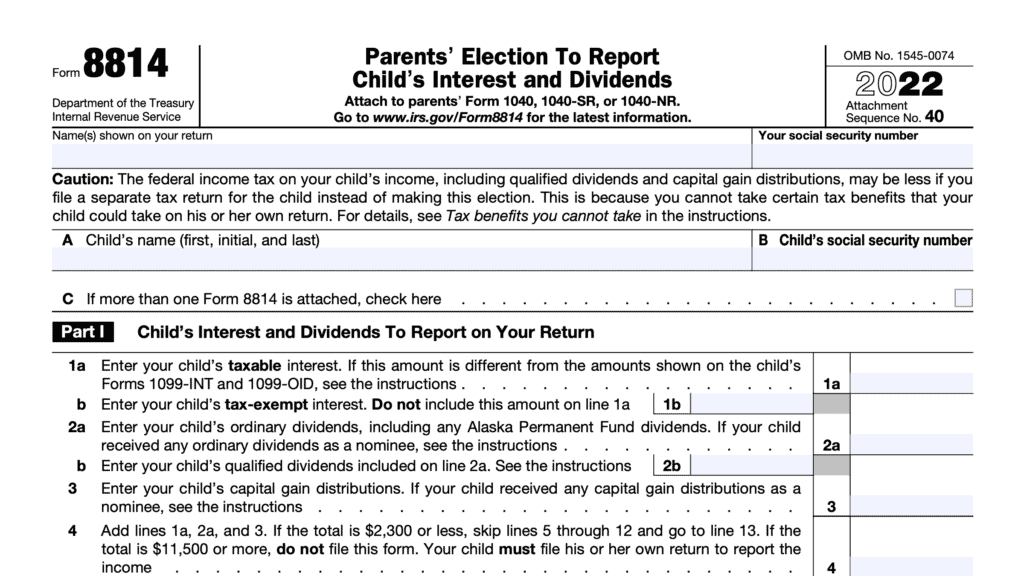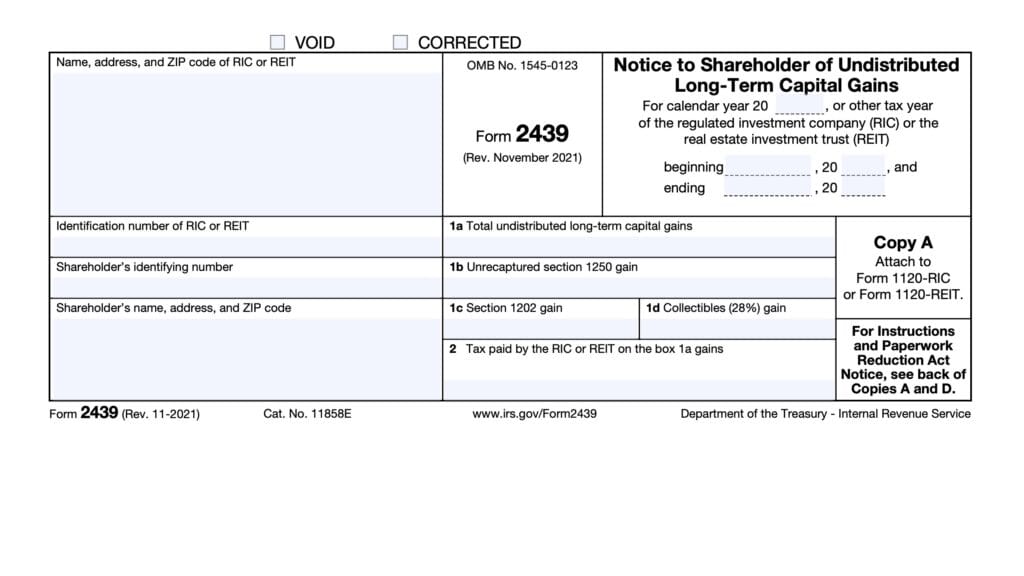IRS Form 1099-DIV Instructions
If you have investments that produce dividend income or capital gain distributions, you should expect to receive IRS Form 1099-DIV. While your financial institution is responsible for issuing this tax document, it’s worth taking the time to understand how to report this information on your income tax return.
In this article, we’ll help you understand everything you need to know about IRS Form 1099-DIV, including:
- What you should expect to see in each box on this form
- How this tax information will impact your income tax return
- When you should expect your Form 1099-DIV and what to do if you do not receive it on time
Let’s start by breaking down this tax form, one step at a time.
Table of contents
IRS Form 1099-DIV Instructions
In most of our articles, we walk you through how to complete the tax form. However, since Form-1099 is issued to taxpayers for informational purposes, most readers will probably want to understand the information reported on their 1099-DIV form, instead of how to complete it.
Before we start breaking down this tax form, it’s important to understand that there can be up to 5 copies of Forms 1099-DIV. Here is a break down of where all these forms end up:
- Copy A: Internal Revenue Service center
- Copy B: For recipient’s tax records
- Copy C: For payer’s tax records
- Copy 1: For state, city, or local tax department
- Copy 2: To be filed with employee’s state, city, or local tax return
For employees who do not pay state, city, or local income tax, copies 1 and 2 are optional.
Let’s get into the form itself, starting with the information fields on the left side of the form.
Taxpayer identification fields
Payer’s name, address, and telephone number
You should see the financial institution’s complete name, address, and telephone number in this field.
Payer’s TIN
This is the payer’s taxpayer identification number (TIN). In most situations, this will be the employer identification number (EIN).
The payer’s TIN should never be truncated.
Recipient’s TIN
As the recipient or payee, you should see your taxpayer identification number in this field. For payees, the TIN can be any of the following:
- Social Security number (SSN)
- Individual taxpayer identification number (ITIN)
- Adoption taxpayer identification number (ATIN)
- Employer identification number (EIN)
Please review this field to make sure that it is correct. However, you may see a truncated form of your TIN (such as the last four digits of your SSN), for privacy protection purposes. Copy A, which is sent to the Internal Revenue Service, is never truncated.
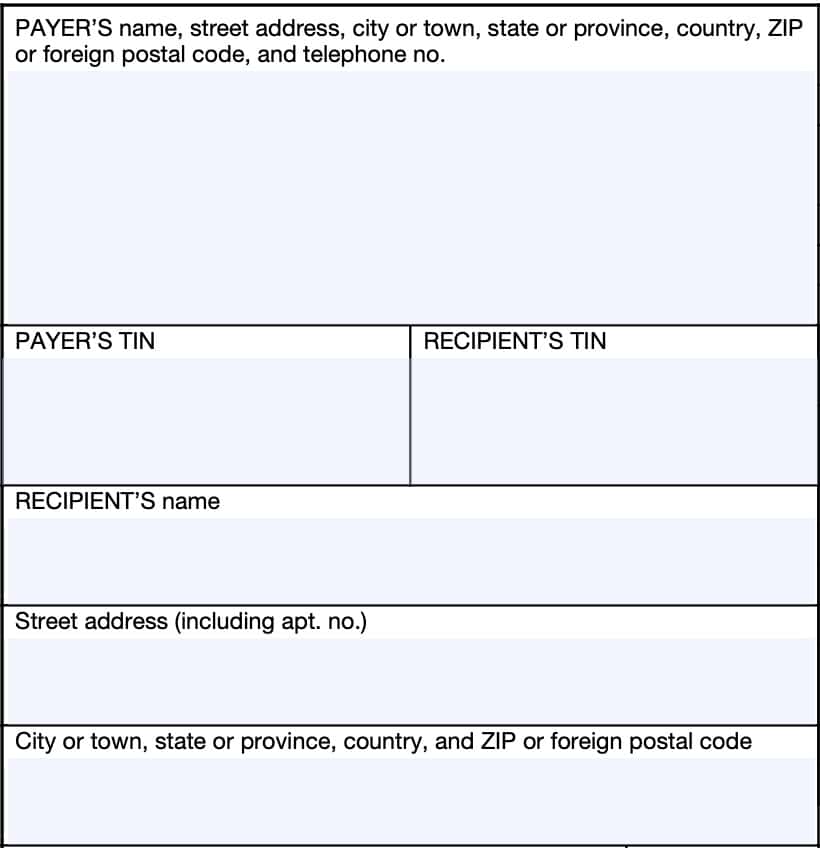
Recipient’s name and address
You should see your name and address reflected in these fields. If your address is incorrect, you should notify the financial institution and the IRS.
You can notify the IRS of your new address by filing IRS Form 8822, Change of Address. Business owners can notify the IRS of a change in their business address by filing IRS Form 8822-B, Change of Address or Responsible Party, Business.
Boxes 1 through 10
On the right-hand side of the form are boxes 1 through 10. In most circumstances, some of these boxes will be blank.
However, let’s go through each box so we can better understand what you should expect to see, and where you should report it on your federal income tax return.
Box 1a: Total ordinary dividends
In Box 1a, you should see the total amount of dividends issued from the payer during the calendar year. This includes dividends from:
- Money market funds
- Net short-term capital gains from mutual funds, and
- Other distributions on stock
- Reinvested dividends
- Section 404(k) dividends paid directly from a corporation
Box 1a will include amounts entered in the following other boxes:
- Box 1b: Qualified dividends
- Box 2e: Section 897 ordinary dividends
- Box 6: Recipient’s share of investment expenses
Generally, you’ll report total dividends in Line 3b of your Form 1040, Form 1040-SR, or Form 1040-NR. You may also need to report this amount on Line 5 of IRS Schedule B, if required.
Box 1b: Qualified dividends
Box 1b will contain the portion of the dividends from Box 1a that qualifies for a lower capital gains tax rate, instead of the ordinary income tax rate.
This may include dividends where it is impractical for the financial institution to determine whether the Section 1(h)(11)(B)(iii) holding period requirement has been met, to qualify for long-term capital gains treatment.
Qualified dividends Exceptions
In general, the IRS considers qualified dividends to be dividends paid during the tax year by domestic corporations and qualified foreign corporations, except for:
- Dividends the recipient received on any share of stock held for less than 61 days during the 121-day period that began 60 days before the ex-dividend date
- Dividends attributable to periods totaling more than 366 days that the recipient received on any share of preferred stock held for less than 91 days during the 181-day period that began 90 days before the ex-dividend date
- Dividends that relate to payments that the recipient is obligated to make with respect to short sales or positions in substantially similar or related property
- Dividends paid by a regulated investment company (RIC) that are not treated as qualified dividend income under Internal Revenue Code Section 854
- Dividends paid by a real estate investment trust (REIT) that are not treated as qualified dividend income under IRC Section 857(c)
- Deductible dividends paid on employer securities
This box cannot contain a negative number. Your qualified dividend total should never be less than zero.
In general, you’ll report qualified dividends in Line 3a of your Form 1040, Form 1040-SR, or Form 1040-NR.
Box 2a: Total capital gain distributions
This box will contain total capital gains distributions (long-term). This should include the total amounts from the following boxes:
- Box 2b: Unrecaptured Section 1250 gain
- Box 2c: Section 1202 gain
- Box 2d: Collectibles (28%) gain
- Box 2f: Section 897 capital gain
Let’s take a look at the first of these, unrecaptured Section 1250 gain.
Box 2b: Unrecaptured Section 1250 gain
If there is an amount reported here, you may need to complete the Unrecaptured Section 1250 gain worksheet, located in the IRS Schedule D instructions, to calculate the amount you enter on Schedule D. If applicable, you’ll enter the calculated amount on Line 19 of Schedule D.
What is unrecaptured Section 1250 gain?
Unrecaptured Section 1250 gain relates to rental real estate property where depreciation was taken or eligible to be taken on previous income tax returns. The maximum capital gains rate associated with unrecaptured Section 1250 gain is 25%.
This video tutorial walks through the unrecaptured Section 1250 gain worksheet so you can better understand how to report on Schedule D.
Box 2c: Section 1202 gain
Box 2c contains any amount included in Box 2a that is a Section 1202 gain from certain qualified small business stock.
What is Section 1202 gain?
Section 1202 allows you to exclude a portion of the eligible gain on the sale or exchange of qualified small business (QSB) stock.
This percentage can range from 50% to 100% depending on when you acquired the stock, as long as you held the stock for at least 5 years and meet other IRS criteria. The maximum tax rate on any Section 1202 gain that is included in income is 28%.
Reporting Section 1202 gain
If you received a Form 1099-DIV with a gain in Box 2c, part or all of that gain may be eligible
for the Section 1202 exclusion.
Report the total gain (box 2a) on Schedule D, Line 13.
Report the following information in the appropriate columns on IRS Form 8949, Sales and Dispositions of Capital Assets:
- Column (a): Name of the corporation whose stock was sold
- Column (f): ‘Q’
- Column (g): Enter the amount of the excluded gain as a negative number
If you are also completing Line 18 on Schedule D, you may need to make adjustments to the 28% Rate Gain worksheet (details in Box 2d, below).
Box 2d: Collectibles (28%) gain
Box 2d contains amounts included in Box 2a attributable to the 28% capital gains rate from the sales or exchanges of collectibles.
If there is an amount here, you may need to complete IRS Form 8949. Additionally, you may need to complete the 28% gains rate worksheet located in the Schedule D instructions to determine the amount you’ll enter on Line 18 of Schedule D.
Box 2e: Section 897 ordinary dividends
Box 2e contains any amounts from Box 1a related to Section 897 gain from dispositions of U.S. real property interests (USRPI).
Most individual taxpayers who are U.S. citizens should not see entries in Box 2e or Box 2f. However, nonresident aliens and foreign corporations may need to account for this on their tax return.
Box 2f: Section 897 capital gain
Box 2f contains any amounts from Box 2a related to Section 897 gain from dispositions of U.S. real property interests (USRPI).
Most individual taxpayers who are U.S. citizens should not see an entry in Box 2f.
Box 3: Nondividend distributions
If determinable, the corporation will report non-dividend distributions to shareholders in Box 3.
As a general rule, Box 3 amounts are considered a return of invested capital. These usually result in a negative adjustment to basis (lowering your tax basis), and taxpayers usually do not need to report them on their individual tax return.
However, IRS Publication 550, Investment Income and Expenses, instructs taxpayers to report any amounts in excess of your investment basis on IRS Form 8949 in the following manner:
- Use Part I to report amounts on mutual fund shares held for 1 year or less
- Use Part II to report amounts on mutual fund shares held for over 1 year
Box 4: Federal income tax withheld
You should see backup withholding amounts reported in Box 4. If you have not given your TIN to the financial institution, you may be subject to backup withholding on certain dividend payments reported on IRS Form 1099-DIV.
In this case, you may be asked to complete IRS Form W-9, Request for Taxpayer Identification Number and Certification, so they can report the correct TIN to the IRS. Foreign recipients may be asked to complete IRS Form W-8 instead.
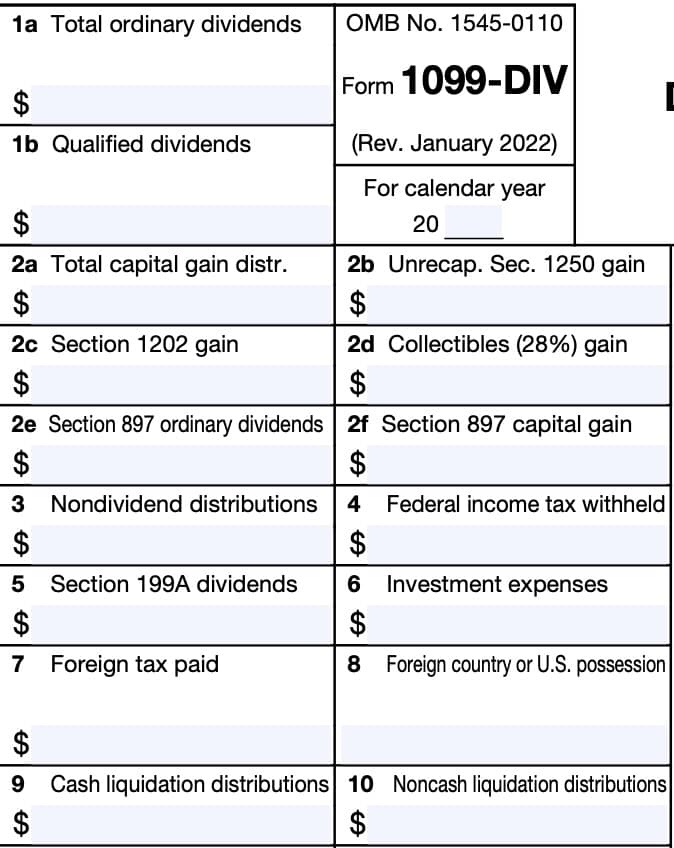
Box 5: Section 199A dividends
If you received dividends from a REIT, or Section 199A dividends paid by a regulated investment company, that amount will be included in Box 5. This amount is also included in the amount reported in Box 1a.
This also includes REIT dividends, besides capital gains dividends or qualified dividends, where the REIT cannot determine whether you’ve met the holding period requirement as described in Treasury Regulations Section 1.199A-3(c)(2)(ii).
Although REIT dividends are already included in taxable income, you may be able to claim a qualified business income (QBI) tax deduction on either:
- IRS Form 8995, Qualified Business Income Deduction, Simplified Computation, or
- IRS Form 8995-A, Qualified Business Income
Box 6: Investment expenses
This box will contain your pro rata share of certain amounts deductible by a nonpublicly offered RIC in computing its taxable income.
This amount is includible in the recipient’s gross income under IRC Section 67(c) and must also be included in Box 1a. Since Box 1a includes these investment expenses, you do not need to account for them separately in your annual tax return.
Box 7: Foreign tax paid
If applicable, Box 7 will contain any foreign tax paid on dividends and other distributions on stock.
A regulated investment company must report only the amount it elects to pass through to you. This amount should appear in U.S. dollars, regardless of the country where the foreign tax was paid.
You may be able to reduce your taxable income by the amount of foreign tax paid by filing IRS Form 1116, Foreign Tax Credit. Under certain circumstances, you may be able to claim this tax credit without having to file Form 1116.
Box 8: Foreign country or U.S. possession
If applicable, Box 8 should contain the name of the foreign country or U.S. possession for which the foreign tax was paid and reported in Box 7.
However, there are certain situations in which investment companies do not need to complete this box.
Box 9: Cash liquidation distributions
Box 9 and Box 10 generally only pertain to corporations in partial or complete liquidation.
If applicable, Box 9 contains cash that was distributed as part of a liquidation event.
Box 10: Noncash liquidation distributions
Box 10 contains noncash distributions that were made as part of a liquidation. If applicable, this should reflect the fair market value as of the date of distribution.
Boxes 11 through 13
At the bottom of the form, you’ll see Boxes 11 through 16. Before reviewing those fields, let’s discuss the other fields that you’ll see on the left-hand side of the form.
Account number
If applicable, you’ll see an account number posted in this box. Although the IRS encourages financial institutions to include an account number, an account number is only required if:
- You are receiving multiple 1099-DIV forms from the same institution for different accounts, or
- If Box 11 is checked
Box 11: FATCA filing requirement
The reporting institution will check the FATCA filing requirement box if it needs to satisfy certain reporting requirements related to the Foreign Account Tax Compliance Act (FATCA).
If the payer has checked this box, you may need to complete IRS Form 8938, Statement of Specified Foreign Financial Assets, if your reported foreign assets exceed the reporting threshold.
Box 12: Exempt-interest dividends
If you received exempt-interest dividends from a mutual fund or other RIC, they will report those dividends in Box 12.
Box 12 also includes any amounts reported in Box 13.
Report any exempt-interest dividends in Line 2a on your IRS Form 1040, or Form 1040-SR.
Box 13: Specified private activity bond interest dividends
Box 13 contains any specified private activity bond interest dividends. Even though they are tax-exempt for income tax purposes, these dividends may be subject to alternative minimum tax (AMT).
These amounts are already included in the amounts reported on Line 2a of your tax return. However, you may also need to report them on IRS Form 6251, Alternative Minimum Tax.

State tax information
Boxes 14 through 16 contain state income tax information. If you live in a state without an income tax, these fields may be left blank.
Box 14: State
If you live in a state without income tax, you may not see any information in Boxes 14 through 16. However, Boxes 14 through 16 may contain relevant tax information for up to 2 different states.
If applicable, Box 14 will contain the abbreviated name of the applicable state(s).
Box 15: State identification number
If your financial institution has a specific state tax identification number, that TIN will appear in Box 15.
Box 16: State tax withheld
Box 16 contains any state income tax withheld on income items reported on Form 1099-DIV.
Filing IRS Form 1099-DIV
For tax entities who must file this tax form with the Internal Revenue Service, the IRS requires certain paper versions of information returns to be accompanied by IRS Form 1096, Annual Summary and Transmittal of U.S. Information Returns.
Check out our step-by step instructional guide for more information on how to submit your information return with IRS Form 1096.
Video walkthrough
Watch this instructional video to learn more about reporting your dividend and distribution income when filing your income tax return.
Do you use TurboTax?
If you don’t, is it because the choices are overwhelming to you?
If so, you should check out our TurboTax review page, where we discuss each TurboTax software product in depth. That way, you can make an informed decision on which TurboTax offering is the best one for you!
Click here to learn more about which TurboTax option is best for you!
Frequently asked questions
The IRS requires financial institutions to issue Form 1099-DIV by January 31 of the year following the tax year they issued dividends. This requirement only applies in situations where the recipient received more than $10 in dividend income during the year.
The IRS recommends that you first contact your financial institution. If you still haven’t received Form 1099-DIV by February 15, you may call the IRS at: 800-829-1040 for additional assistance.
The IRS expects taxpayers to report all income on their tax return. However, if you received less than $10 in dividend income during the tax year, the IRS does not require your financial institution to file IRS Form 1099-DIV, nor should you expect to receive one.
Where can I find IRS Form 1099-DIV?
As with other tax forms, you may find IRS Form 1099-DIV on the IRS website. For your convenience, we’ve included the most recent copy of the form in this article.
Related tax articles
This tax form is one of the fillable tax forms provided by the Internal Revenue Service, to help taxpayers reduce their tax preparation costs. To see more forms like this, visit our free fillable tax forms page, where you’ll also find articles like this.
Unlike the IRS, our articles contain step by step instructions for each tax form, as well as video walkthroughs. You can also check out all of our videos by subscribing to our YouTube channel!



